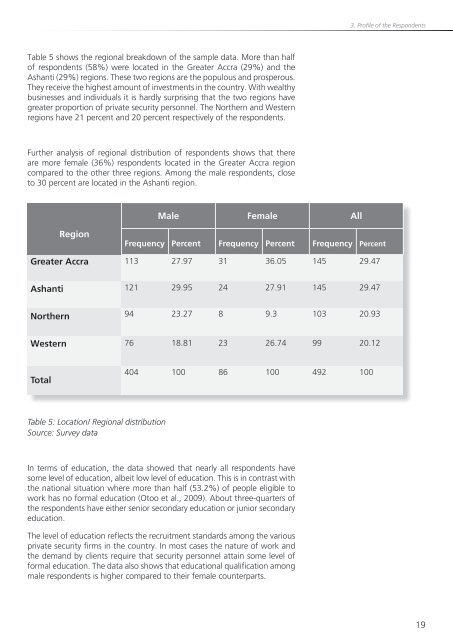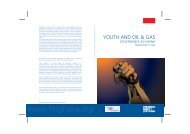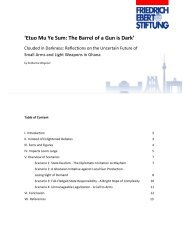Wages and Working Conditions of Private Security Workers in Ghana
Wages and Working Conditions of Private Security Workers in Ghana
Wages and Working Conditions of Private Security Workers in Ghana
You also want an ePaper? Increase the reach of your titles
YUMPU automatically turns print PDFs into web optimized ePapers that Google loves.
3. Pr<strong>of</strong>ile <strong>of</strong> the Respondents<br />
Table 5 shows the regional breakdown <strong>of</strong> the sample data. More than half<br />
<strong>of</strong> respondents (58%) were located <strong>in</strong> the Greater Accra (29%) <strong>and</strong> the<br />
Ashanti (29%) regions. These two regions are the populous <strong>and</strong> prosperous.<br />
They receive the highest amount <strong>of</strong> <strong>in</strong>vestments <strong>in</strong> the country. With wealthy<br />
bus<strong>in</strong>esses <strong>and</strong> <strong>in</strong>dividuals it is hardly surpris<strong>in</strong>g that the two regions have<br />
greater proportion <strong>of</strong> private security personnel. The Northern <strong>and</strong> Western<br />
regions have 21 percent <strong>and</strong> 20 percent respectively <strong>of</strong> the respondents.<br />
Further analysis <strong>of</strong> regional distribution <strong>of</strong> respondents shows that there<br />
are more female (36%) respondents located <strong>in</strong> the Greater Accra region<br />
compared to the other three regions. Among the male respondents, close<br />
to 30 percent are located <strong>in</strong> the Ashanti region.<br />
Male Female All<br />
Region<br />
Frequency Percent Frequency Percent Frequency Percent<br />
Greater Accra 113 27.97 31 36.05 145 29.47<br />
Ashanti 121 29.95 24 27.91 145 29.47<br />
Northern 94 23.27 8 9.3 103 20.93<br />
Western 76 18.81 23 26.74 99 20.12<br />
Total<br />
404 100 86 100 492 100<br />
Table 5: Location/ Regional distribution<br />
Source: Survey data<br />
In terms <strong>of</strong> education, the data showed that nearly all respondents have<br />
some level <strong>of</strong> education, albeit low level <strong>of</strong> education. This is <strong>in</strong> contrast with<br />
the national situation where more than half (53.2%) <strong>of</strong> people eligible to<br />
work has no formal education (Otoo et al., 2009). About three-quarters <strong>of</strong><br />
the respondents have either senior secondary education or junior secondary<br />
education.<br />
The level <strong>of</strong> education reflects the recruitment st<strong>and</strong>ards among the various<br />
private security firms <strong>in</strong> the country. In most cases the nature <strong>of</strong> work <strong>and</strong><br />
the dem<strong>and</strong> by clients require that security personnel atta<strong>in</strong> some level <strong>of</strong><br />
formal education. The data also shows that educational qualification among<br />
male respondents is higher compared to their female counterparts.<br />
19









